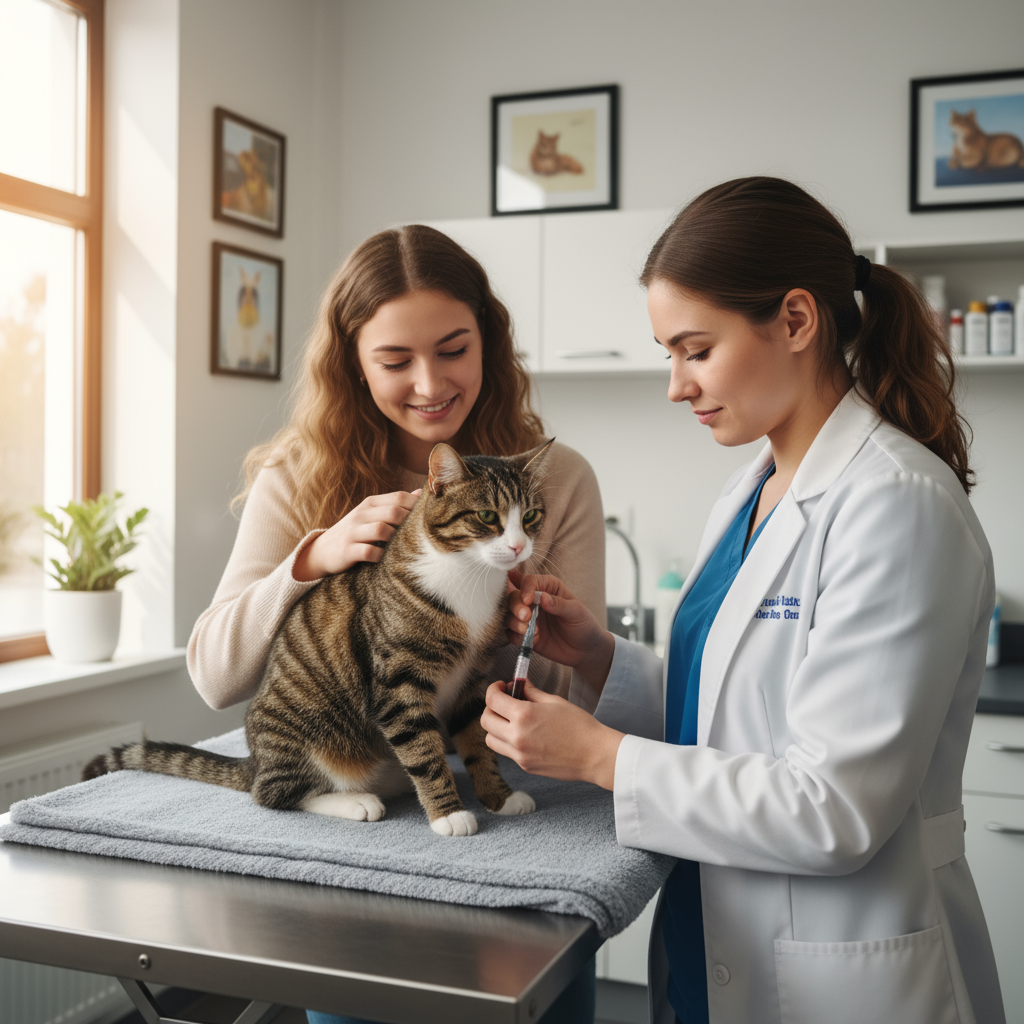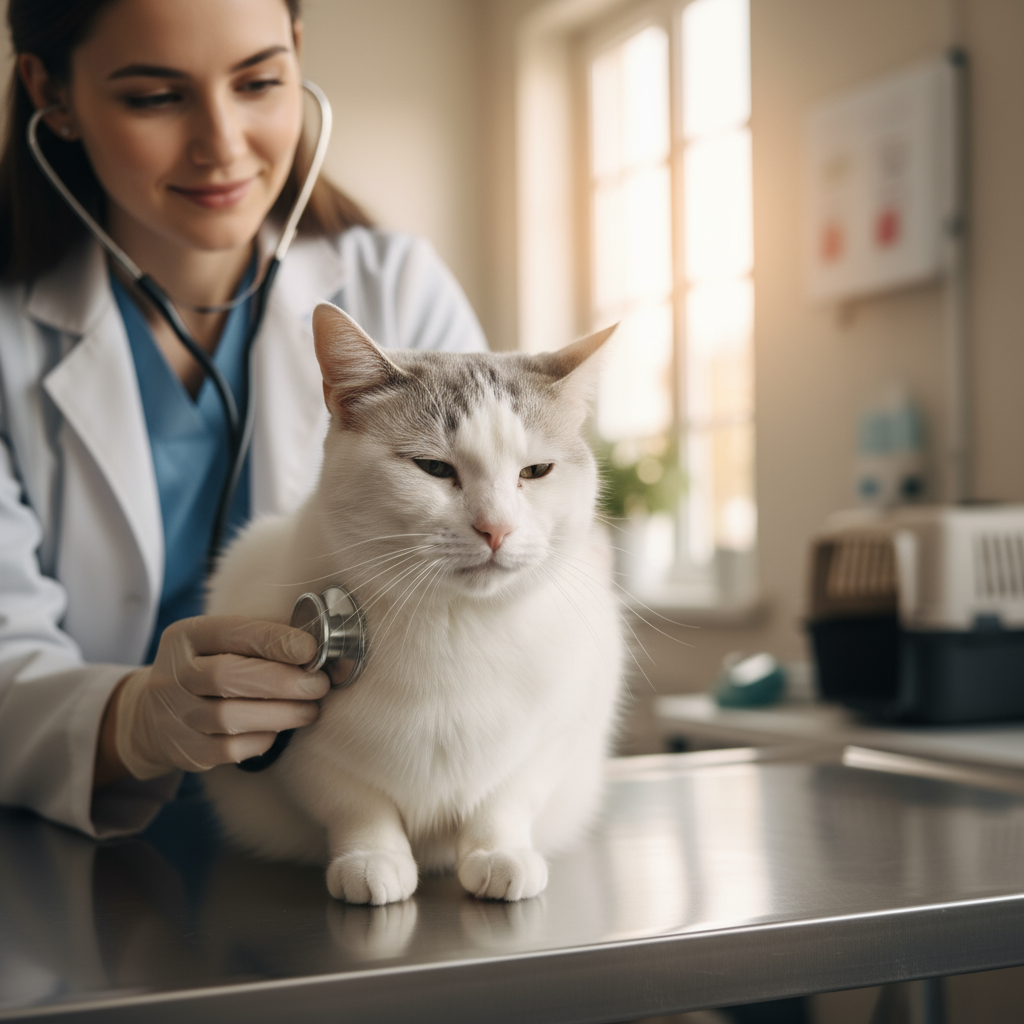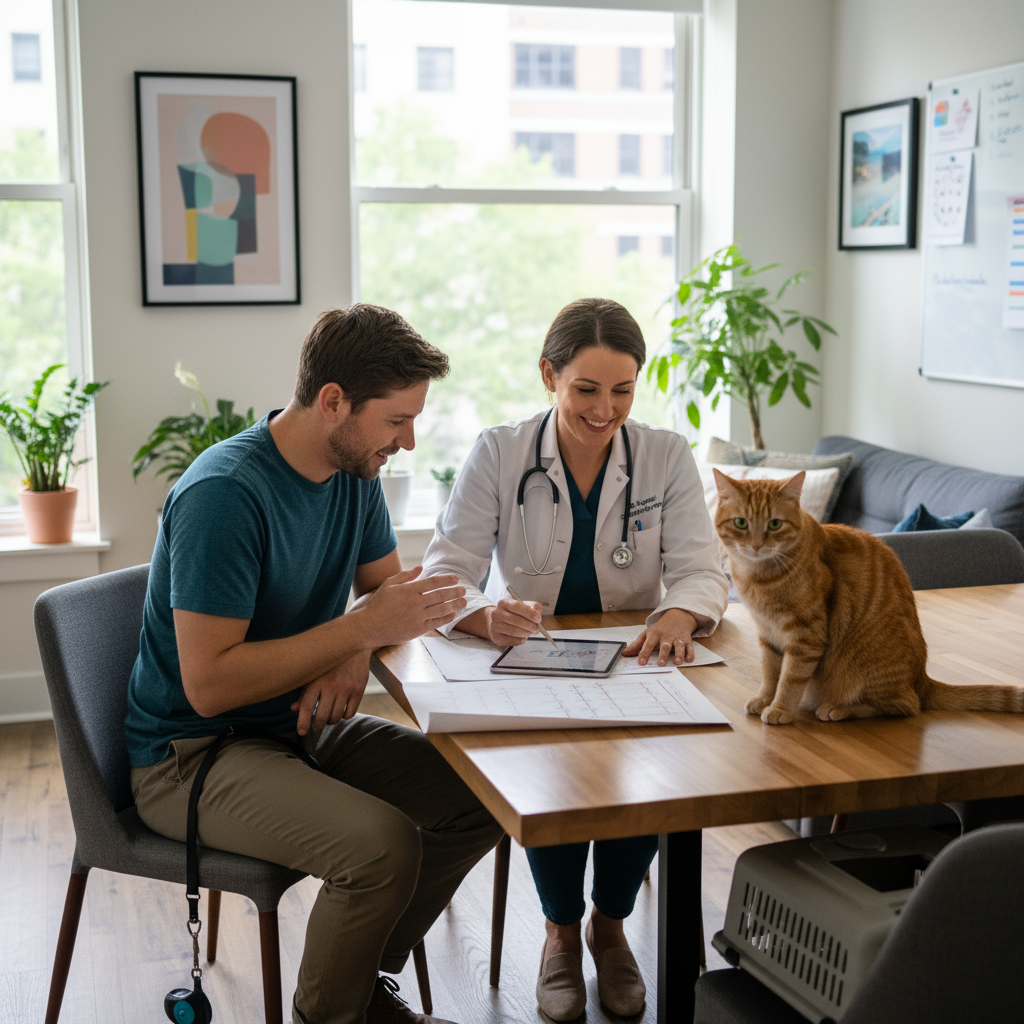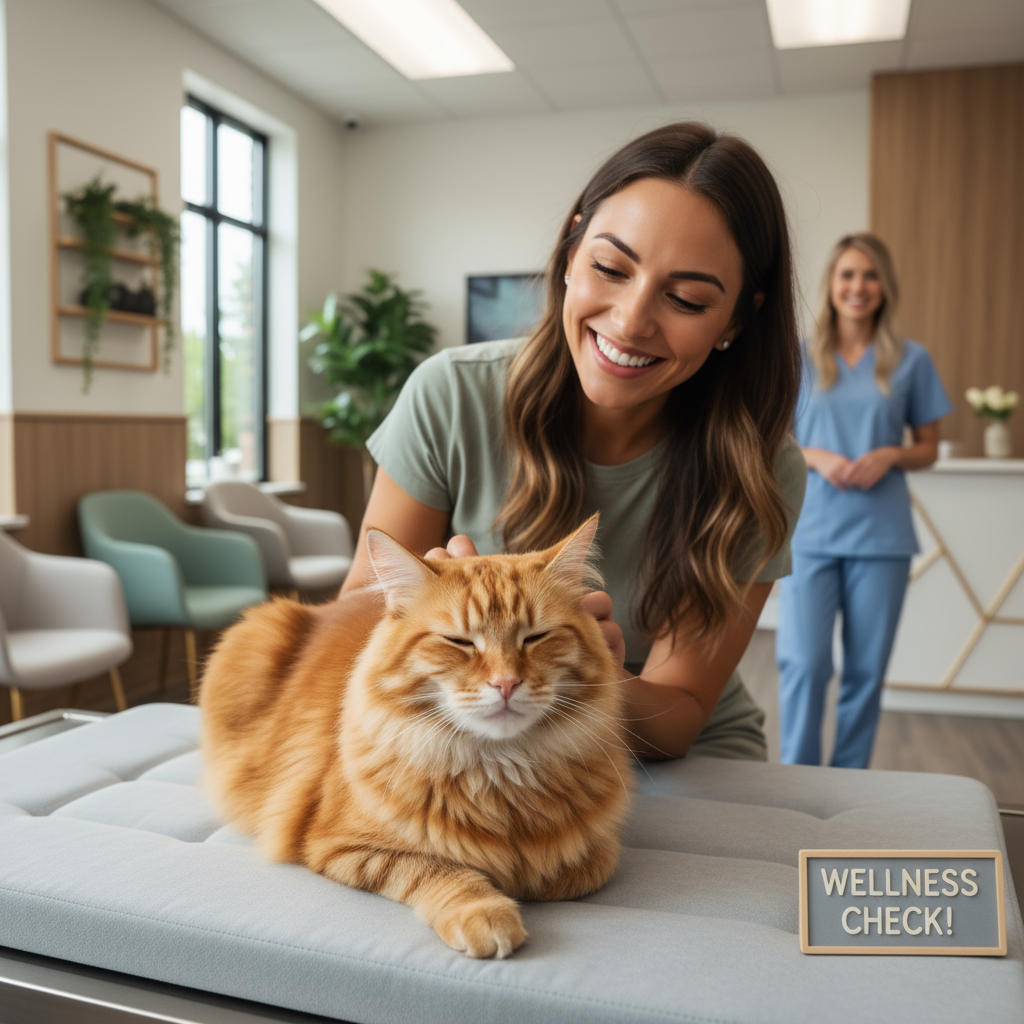Let me guess—you're staring at your perfectly healthy cat lounging in a sunbeam, wondering if you really need to spend money on a vet visit. I mean, she's eating fine, using the litter box, and acting like the queen of the house she's always been. So what's a cat wellness exam actually going to cost you, and is it worth it?
Here's the honest answer: cat wellness exam cost typically range from $50 to $150 for a basic examination, but that's just the starting point. When you add in bloodwork, vaccinations, and testing that cats actually need, you're looking at anywhere from $150 to $400 for a comprehensive visit. And yeah, I know that's not pocket change. But stick with me here, because understanding these costs—and why they matter—could literally save you thousands down the road and add years to your cat's life.
Breaking Down Cat Wellness Exam Cost
So what exactly factors into the cat wellness exam cost during a pet health checkup? Let me break it down the way I explain it to cat owners in my clinic every single day.
The base examination fee covers my time doing a complete nose-to-tail physical assessment of your cat. In most areas of the country, this runs between $50-75 for a standard appointment. In major cities like New York, San Francisco, or Boston, you might see $100-150 for the same service. Rural areas tend to be on the lower end, around $45-65.
But here's where it gets interesting—and where costs add up. That base exam fee is really just getting you in the door. For cats especially, the physical exam only tells part of the story. Cats are masters at hiding illness. Like, Olympic-level masters. They've evolved to conceal weakness because in the wild, sick cats become prey. So by the time your cat shows obvious symptoms, they're often seriously ill.
This is why comprehensive pet wellness exams for cats need to include diagnostic testing. A wellness visit for an adult or senior cat that includes bloodwork, urinalysis, and parasite screening typically totals $200-400. That might sound like a lot, but let me put it in perspective with a real story from my practice.
A client brought in her 9-year-old cat for a routine exam. The cat seemed fine—good appetite, normal behavior, maybe drinking a bit more water than usual, but nothing alarming. Just the physical exam would have cost $65. I recommended senior bloodwork for an additional $180. The owner hesitated because of the cost, but ultimately agreed.
Good thing she did. That bloodwork revealed early kidney disease and hyperthyroidism—both incredibly common in older cats and both completely manageable when caught early. We started treatment immediately. Total cost for managing both conditions? About $50-80 per month for medication and prescription food, plus monitoring bloodwork every few months.
Now here's the kicker: if we'd waited until that cat showed obvious symptoms, we'd be dealing with advanced kidney failure and thyroid storm. Hospitalization for kidney failure runs $2,000-5,000. The cat would have suffered. Treatment outcomes would be way worse. And the owner would face both massive bills and heartbreaking decisions.
That $245 wellness visit literally saved thousands of dollars and added years to that cat's life. This is why I'm so passionate about comprehensive pet health checkups, even when they cost more upfront.

What You're Actually Getting for Your Money
Let me walk you through what happens during a thorough cat wellness exam so you understand exactly what the cat wellness exam cost covers.
The Physical Examination
I start with your cat's eyes. I'm checking for cloudiness that might indicate cataracts or high blood pressure, changes in pupil size or response, and signs of inflammation or infection. Eye problems in cats can signal everything from hypertension to diabetes to cancer.
Next come the ears. Cats get ear mites, infections, and polyps that owners often don't notice until the cat is miserable. I'm looking inside with an otoscope, checking for redness, discharge, odor, or masses.
The mouth gets serious attention. Dental disease affects over 70% of cats by age three. I'm talking about painful infected gums, rotting teeth, and oral tumors that cats hide incredibly well. Dental disease isn't just a mouth problem—those bacteria enter the bloodstream and damage the heart, liver, and kidneys. Catching dental issues during routine exams saves cats from suffering and saves owners from expensive emergency extractions down the line.
I palpate the abdomen carefully, feeling the size and shape of internal organs. This is huge for cats because I can often detect enlarged kidneys, masses, intestinal problems, or bladder issues before symptoms appear. Cats with bladder stones or urinary blockages can go from "seems fine" to life-threatening emergency in hours, so finding problems early matters enormously.
Listening to the heart and lungs tells me about cardiovascular health. Heart murmurs and abnormal rhythms are surprisingly common in cats, especially certain breeds. Early detection allows treatment that prevents heart failure.
I assess body condition score because obesity is epidemic in indoor cats—over 60% are overweight or obese. Extra weight causes diabetes, arthritis, liver disease, and shortened lifespan. But sudden weight loss is equally concerning and often indicates serious illness like hyperthyroidism, diabetes, or cancer.
Finally, I examine the skin and coat, check mobility and joint health, and watch how your cat moves. Arthritis affects most senior cats but gets missed constantly because cats adjust their behavior rather than limping obviously like dogs do.
This thorough exam takes 20-30 minutes and forms the foundation of the cat wellness exam cost you're paying.
Vital Signs and Documentation
I take temperature, heart rate, and respiratory rate, creating baseline data for your individual cat. This seems simple but provides critical comparison points for future visits. Your cat's normal might be different from typical ranges, and knowing their baseline helps me detect subtle changes that indicate developing problems.

Here's where cat wellness exam cost increase beyond the basic examination, but also where we catch the problems that physical exams miss.
Understanding each component of the cat wellness exam cost helps you budget appropriately and see the value in comprehensive testing.
Bloodwork: The Game-Changer ($80-200)
For adult and senior cats, I strongly recommend annual bloodwork. A Complete Blood Count (CBC) runs about $50-80 and checks red blood cells, white blood cells, and platelets. This reveals anemia, infections, inflammatory conditions, and blood disorders.
The chemistry panel costs $80-150 and is absolutely essential for cats. This is where we detect kidney disease, liver problems, diabetes, hyperthyroidism, and electrolyte imbalances. Remember that cats lose 75% of kidney function before it shows up on bloodwork, so catching even subtle increases early is crucial.
For senior cats over age 8, I recommend a complete geriatric panel including thyroid testing. This runs $150-200 total but screens for the most common diseases affecting older cats. Hyperthyroidism alone affects 10-15% of senior cats, and it's completely treatable when caught early but devastating when it progresses.
Is bloodwork expensive? Compared to what? Managing early kidney disease costs maybe $200-400 annually for prescription food and monitoring. Treating kidney failure costs $2,000-5,000 for hospitalization with poor outcomes. Managing hyperthyroidism costs $30-50 monthly for medication. Not treating it leads to heart failure, weight loss, and death.
The bloodwork cost is hands-down the best money you'll spend on your cat's healthcare.
Urinalysis: Essential for Cats ($25-50)
Cats are prone to kidney disease, diabetes, and urinary tract problems. Urine testing catches these before blood tests do in many cases. I can't tell you how many times urinalysis has revealed early kidney disease, diabetes, bladder infections, or crystal formation that would have become life-threatening blockages.
For male cats especially, this test can be lifesaving. Urinary blockages kill male cats fast—we're talking 24-48 hours from first symptoms to death if untreated. Finding crystals during a routine wellness exam lets us change diet and prevent blockage altogether.
Parasite Testing ($25-50)
Even indoor cats need annual fecal testing. Intestinal parasites are more common than most owners realize, and some transmit to humans. A fecal test runs $25-35.
For cats who go outdoors or live in multi-cat households, I also recommend FeLV/FIV testing every 1-2 years. This combination test costs $35-50 and screens for feline leukemia virus and feline immunodeficiency virus—both serious diseases that affect how we manage your cat's health.
Vaccinations ($15-30 each)
Core vaccines that every cat needs include FVRCP (feline viral rhinotracheitis, calicivirus, panleukopenia) and rabies. FVRCP runs $15-25 per dose, rabies $15-30. Indoor-only cats might not need every vaccine annually—we've learned that many vaccines provide protection for three years rather than one.
Outdoor cats or those in boarding situations need the feline leukemia vaccine, which costs $20-30. We tailor vaccination schedules to your cat's individual risk factors, so you're not paying for unnecessary vaccines.
Blood Pressure Monitoring ($25-40)
For senior cats, blood pressure screening is essential. Hypertension is common in older cats and has no obvious symptoms until it causes sudden blindness, kidney damage, or stroke-like events. This simple test costs $25-40 and allows treatment before damage occurs.
Cat Wellness Exam Cost by Age and Life Stage
The cost of pet wellness exams varies significantly based on your cat's age and health needs. Let me break down what to expect at each stage.
Kittens: Birth to One Year ($300-500 total first year)
Kittens need frequent visits—typically at 8, 12, and 16 weeks for their vaccine series, then again at 6 months and one year. Each visit runs $75-125 including examination, vaccinations, and deworming.
That first year total sounds high at $300-500, but you're getting multiple exams, complete vaccine series, parasite prevention, nutritional counseling, and behavioral guidance. This is also when we discuss spay/neuter timing and costs (typically $150-300 depending on gender and your location).
These early visits set the foundation for a healthy adult cat. We catch congenital problems, establish good nutrition habits, and ensure proper socialization. Missing vaccines or spacing them incorrectly leaves kittens vulnerable to fatal diseases like panleukopenia.
Adult Cats: 1-7 Years ($150-250 annually)
Healthy young adult cats do well with annual exams.A typical cat wellness exam cost for adults including physical exam, vaccines if needed, fecal test, and basic bloodwork (starting around age 4-5) runs $150-250. (starting around age 4-5) runs $150-250.
Indoor-only cats in good health might be on the lower end. Cats who go outdoors, live with other cats, or have breed-specific health risks might need additional testing that increases costs.
This is the stage where many cat owners skip wellness exams because their cat seems fine. Don't do this. Problems develop silently, and establishing baseline bloodwork while your cat is healthy makes detecting changes later much easier.
Dental cleanings typically become necessary during the adult years. Professional cleaning under anesthesia costs $300-800 depending on the severity of dental disease and whether extractions are needed. Regular wellness exams help us monitor dental health and plan cleaning before disease becomes severe and expensive.

Senior Cats: 7+ Years ($300-600 annually)
This is where cat wellness exam cost increase, but also where they provide the most value. Cats are considered senior around age 7-8, and things change fast at this stage. I strongly recommend twice-yearly exams for senior cats, along with comprehensive bloodwork and blood pressure monitoring.
A typical senior wellness visit runs $150-300 including exam, complete bloodwork panel with thyroid testing, urinalysis, and blood pressure check. Twice yearly, you're looking at $300-600 annually for preventive care.
Is this expensive? Let's talk about what we're preventing. Kidney disease, hyperthyroidism, diabetes, high blood pressure, arthritis, dental disease, and cancer all become increasingly common after age 7. Every single one of these conditions is more manageable and less expensive when caught early.
Hyperthyroidism treatment costs $30-50 monthly for medication, or $1,200-1,800 for radioactive iodine treatment that cures the disease permanently. Not treating it leads to heart failure and death. Which would you prefer?
Early kidney disease management costs $30-60 monthly for prescription food. Kidney failure hospitalization costs thousands with poor outcomes.
Diabetes caught early and managed properly costs $50-80 monthly for insulin and monitoring. Diabetic ketoacidosis treatment costs $3,000-5,000 as an emergency.
Those senior wellness exams aren't expenses—they're investments that typically save you thousands while giving your cat more quality years.
Geographic Variations in Cat Wellness Exam Cost
Where you live significantly impacts the cat wellness exam cost you'll pay. Here in Austin, Texas, a basic cat exam runs $60-85 at most general practices. Head to Manhattan, and you're looking at $125-175 for the same service.
Urban areas have higher costs due to rent, staff salaries, and overall cost of living. Veterinary care pricing reflects local economics. San Francisco, Seattle, Boston, New York, and Los Angeles are consistently on the high end. Rural areas in the Midwest and South tend to be most affordable.
Specialty or emergency hospitals charge more than general practice clinics—sometimes 2-3 times more. This doesn't mean better care necessarily; you're paying for specialized equipment, board-certified specialists, and 24/7 availability.
Low-cost clinics and nonprofit organizations offer reduced fees, typically $30-50 for basic exams. These are excellent options for routine wellness care, though they may have limited appointment availability and might not offer all services general practices provide.
Making Cat Wellness Exams Affordable
I completely understand that cat wellness exam cost can strain budgets, especially if you have multiple cats. Let me share some strategies that help my clients manage these expenses.
Let's explore practical strategies to manage cat wellness exam cost without compromising your cat's health.
Wellness Plans: Spreading Costs Throughout the Year
Many veterinary clinics now offer wellness plans where you pay a monthly fee that covers routine preventive care. Plans typically cost $30-60 monthly depending on your cat's age and what's included.
A typical adult cat wellness plan might include:
- Two annual exams
- Vaccinations
- Annual bloodwork
- Parasite testing and prevention
- Discounts on additional services (dental cleanings, medications)
The math usually works in your favor. You'd pay $400-500 for these services separately, but the wellness plan costs $360-720 annually ($30-60 x 12 months). Plus, the monthly payment makes budgeting much easier than facing a $300 bill once a year.
Senior cat plans cost more ($45-80 monthly) but include twice-yearly exams, comprehensive bloodwork, and additional monitoring that senior cats need.

Pet Insurance with Wellness Riders
Standard pet insurance covers illness and accidents but not routine care. However, many companies now offer wellness riders for an additional $10-25 monthly that reimburse for annual exams, vaccinations, and routine testing.
Pet insurance makes most sense when you start while your cat is young and healthy. Premiums for young cats run $20-40 monthly for accident and illness coverage. Adding a wellness rider brings it to $30-65 monthly total.
The benefit? When your cat develops a chronic condition like diabetes or kidney disease, insurance covers ongoing treatment costs that can run hundreds monthly. Wellness riders offset routine preventive care costs.
Read policies carefully. Some have annual limits, waiting periods, or exclusions. Companies like Nationwide, Trupanion, Healthy Paws, and Pets Best have different coverage structures and pricing.
Payment Plans and Financial Assistance
Most veterinary practices work with CareCredit, a healthcare credit card offering promotional financing (often 6-12 months interest-free if paid in full). This lets you spread costs over time without interest if you meet payment deadlines.
Some clinics offer in-house payment plans for established clients. It never hurts to ask, especially for larger expenses like senior wellness panels or unexpected findings requiring follow-up.
Low-cost veterinary clinics operated by humane societies or nonprofits provide reduced-fee services based on income. They're primarily focused on spay/neuter and vaccines, but many offer wellness exams for $30-50.
Veterinary schools often have clinics open to the public with reduced fees since students (supervised by experienced veterinarians) provide care. Services might take longer, but you're getting quality care at lower costs.
Some areas have organizations that help low-income families afford veterinary care. The Humane Society website lists resources by state. Don't let financial concerns prevent you from seeking care—options exist, and most of us in veterinary medicine want to help you find solutions.
The Real Value: Prevention vs. Treatment Costs
Let me give you some real numbers comparing preventive pet health checkup costs versus treating advanced disease. This is where the true value becomes crystal clear.
Kidney Disease Example
Annual senior wellness exam with comprehensive bloodwork: $250
Early kidney disease management: $30-60 monthly for prescription diet = $360-720 annually
Your cat maintains good quality of life for years.
Skip wellness exams until symptoms appear:
Kidney failure hospitalization: $2,000-5,000
Ongoing intensive management: $150-300 monthly
Poor quality of life, shorter survival time despite aggressive treatment.
Hyperthyroidism Example
Senior wellness bloodwork catches early hyperthyroidism: $180 for the testing
Treatment with medication: $30-50 monthly = $360-600 annually
Or radioactive iodine cure: $1,200-1,800 one-time cost
Your cat returns to normal health.
Skip wellness exams until cat is skeletal and vomiting:
Emergency hospitalization: $1,500-3,000
Heart damage may be permanent
Treatment same cost but less effective with advanced disease.
Dental Disease Example
Annual wellness exams monitoring dental health: $75-100 yearly
Routine dental cleaning before severe disease: $300-500
Your cat keeps their teeth and avoids pain.
Skip wellness exams until cat stops eating:
Emergency dental work with multiple extractions: $800-1,500
Pain and infection your cat suffered for months or years
Difficulty eating for remainder of life.
Diabetes Example
Wellness bloodwork catches early diabetes: $150
Well-managed diabetes: $50-80 monthly for insulin and monitoring
Regulated diabetic cats can live normal lifespans.
Skip exams until cat is in diabetic crisis:
Emergency DKA treatment: $3,000-5,000
Risk of death even with treatment
Same ongoing management costs but worse outcomes.
I could keep going, but you see the pattern. Comprehensive pet wellness exams cost a few hundred dollars annually. Treating advanced disease costs thousands, involves suffering for your cat, and often has worse outcomes despite aggressive treatment.
The cat wellness exam cost isn't an expense—it's insurance against massive bills and heartbreak down the road.
What Happens When You Skip Wellness Exams
I've seen this scenario play out hundreds of times over 15 years. An owner brings in a cat who "suddenly" got sick. They haven't been to the vet in 2-4 years because the cat seemed fine and money was tight.
But cats didn't "suddenly" develop kidney failure or diabetes or hyperthyroidism. These diseases developed gradually over months or years. The cat hid symptoms brilliantly until they physically couldn't anymore. By then, we're doing crisis management instead of prevention.
Recently, a client brought in a 12-year-old cat who'd stopped eating. The owner hadn't brought her in for a wellness exam in three years. "She seemed totally fine until two days ago," he told me.
Bloodwork revealed severe kidney failure, advanced hyperthyroidism, and diabetes. This cat had been sick for a long time, but cats hide illness until they're critically ill. We hospitalized her, spent $3,500 on emergency treatment, and she died anyway. The owner was devastated, both emotionally and financially.
If that cat had been coming for annual senior wellness exams, we would have caught these problems years earlier when they were manageable. Total cost would have been maybe $200-300 yearly for monitoring and medication. The cat would have had more quality years. The owner would have avoided both the massive emergency bill and the guilt of not knowing his cat was suffering.
I'm not sharing this to make anyone feel bad. I'm sharing it because this happens constantly, and it's preventable. The cat wellness exam cost seems like a lot until you realize what you're preventing.
Questions to Ask About Costs
Don't be shy about discussing money with your veterinarian. Here's what to ask:
"Can you give me an estimate before we do testing?" Absolutely yes. We should provide clear cost estimates for any testing or procedures we recommend.
"What's essential versus optional?" We can prioritize recommendations based on your cat's individual risk factors and your budget. Some things can wait; others can't. We'll help you understand the difference.
"Do you offer payment plans or work with CareCredit?" Most practices do. Ask about options before declining necessary care due to cost.
"Why are you recommending this test?" We should explain clearly why we recommend specific testing and what we're looking for. If you don't understand, keep asking until you do.
"Are there less expensive alternatives?" Sometimes yes, sometimes no. For example, in-house bloodwork machines cost more but provide results in 15 minutes versus sending to an outside lab that's cheaper but takes 24 hours. Depending on the situation, either might be appropriate.
"What happens if we don't do this now?" We can explain the risks of delaying recommended testing or treatment so you can make informed decisions.
Good veterinarians welcome cost discussions. We want you to afford appropriate care for your cat, and we'll work with you to find solutions whenever possible.

Getting Maximum Value from Every Visit
Since you're paying for that cat wellness exam, make the most of it:
Come Prepared
Write down any changes you've noticed—appetite, water consumption, litter box habits, energy level, behavior, vomiting, breathing, mobility. Even subtle changes matter.
Note any new lumps or skin problems. Point them out specifically.
Bring all current medications and supplements with dosages.
Write down your questions beforehand so you don't forget them.
Be Honest
Tell us about your budget constraints upfront. We can prioritize what's most important.
Describe your cat's actual lifestyle—does your "indoor" cat actually slip outside sometimes? We need accurate information to recommend appropriate preventive care.
Follow Through
If we recommend follow-up testing or rechecks, schedule them. We make these recommendations because they matter for your cat's health.
If cost prevents follow-through, tell us so we can explore alternatives rather than having you just not do it.
Ask Questions
There are no stupid questions. We want you to understand your cat's health and our recommendations. Keep asking until things make sense.
The Bottom Line on Cat Wellness Exam Costs
Here's what it comes down to: cat wellness exam costs typically range from $150-400 for a comprehensive annual visit including examination, bloodwork, and necessary testing. For senior cats needing twice-yearly monitoring, you're looking at $300-600 annually.
Is this cheap? No. Is it worth it? Absolutely, without question.
These routine pet wellness exams detect problems when they're manageable and affordable to treat. They prevent emergencies that cost thousands and break your heart. They give your cat more quality years and help you avoid the guilt of not knowing they were sick until it was too late.
Your cat depends entirely on you for their health and wellbeing. They can't tell you when something's wrong, and they're evolutionarily programmed to hide illness. Regular wellness exams are how you protect them, advocate for them, and honor the trust they place in you.
The cat purring on your lap right now deserves preventive care that catches problems early. Don't wait for symptoms. Don't skip exams because they seem healthy. Schedule that wellness visit, and give your cat the gift of early detection and longer, healthier life.
The cat wellness exam cost isn't an expense—it's an investment in more years with the companion you love.





